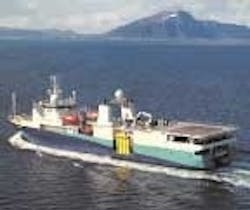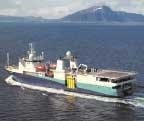Making the prospect cycle spin
New technologies are making "prospect shopping" easier and more efficient. Paper and labor intensive marketing processes are going digital. This transformation is in its early stages and will require a few years to become fully integrated into firms' business processes. Until that time, mass meetings fill the gap. The recent NAPE Expo, formerly North American Prospect Expo, was developed for this purpose, creating an open marketplace for prospects and dealmaking.
When started in 1993, NAPE provided a place for isolated prospect generators to connect with dispersed prospect buyers after the industry's collapse and fragmentation in the late 1980s. It focused many individual marketing efforts into one space and time, to everyone's benefit. It collapsed the cycle time for prospect marketing.
Meeting and discussing oil prospects is what it is about. "Our biggest energy is the people who are employed in the industry," explained Eric Hansen, President of AAPL (American Assoc-iation of Petroleum Landmen). The NAPE marketplace is expanding with the industry and is now showing prospects from all parts of the globe.
Pushing the prospect
Using science to unravel the mysteries of the earth is one of the challenges that keeps geo-types intrigued by the world. However, those studies by themselves don't keep the producer doors open, nor do they get wells drilled. Oil prospects and oil deals must be sold. The science must be correct and support the prospect's story. But the prospect must be compelling and fit the economic need of the reviewer/buyer.
The deal must also be presented to enough potential purchasers to find the right fit. It can be a tough task since selling is not the strongest trait of most explorationists.
If you must "shop" the deal, it is best to show it to many people quickly. That is why personal professional networks are so important.
Prospect listings in newsletter format and even by Internet have been available for a few years. Marketing by way of prospect folder and accompanying data CD (compact disc) is becoming more common, but is a target-marketing approach. To reach the widest possible audience for a given prospect, an open market is the best place.
The marketing process is now transmuting to fully digital Internet datarooms. They can be either individual company sites or open market sites run by neutral third parties. Once qualified registrants can post their prospects and have access to other companies' prospect materials, searches by area, play type, prospect size, or other criteria become easy. Companies and individuals then self-select for their investment situation, and prospect cycle-times drop even more.
Inventory and business velocity
This increase in "business velocity" can create a problem - a thin prospect inventory. This was evident at NAPE this year. In many conversations, this editor heard that "lots of companies are showing what they are doing, but fewer prospects are here than before." Strong gas prospect demand over the last year is one cause, but another wrinkle is the use of the open marketplace to force pre-NAPE decisions by reviewers.
Access
In another developing trend, majors are finding themselves land-rich and prospect-poor due to thinned professional ranks. To overcome this problem, BP in partnership with IndigoPool.com is experimenting with a new form of outsourcing. The process, called VirtualProspecttrademark, is completing its pilot stage. BP created data rooms in IndigoPool's Internet space for five Gulf of Mexico lease areas:
- Matagorda Island 518, 519, and 587
- Matagorda Island 622 and 623
- East Cameron 261 and 264
- East Cameron 222 and 232
- West Cameron 292, 293, and 294.
All available data - seismic, well logs, prod-uction histories, etc. - were placed in the digital dataroom and made available to qualified companies and individuals for use in prospect generation. Once an agreement was struck with BP, the third party had three months to use the data for prospect generation. BP gets first right of refusal on all prospects generated.
The pilot project drew 40 responses, and all five lease areas are under review. BP is pleased with the pilot and plans to expand the offerings to 20-30 new areas in April and May. This could open a new business model for many smaller companies as majors high-grade their leases.
Glacial CD available
The Joint Oceanographic Institutions and the US Science Support Program have developed a new interactive CD-ROM that takes geoscience students on a voyage of discovery on board the Ocean Drilling Program's drillship JOIDES Resolution. Using sediment cores recovered at two ODP sites in the northern Atlantic Ocean and in the Caribbean Sea, students study the growth of ice sheets in the Northern Hemisphere over the past four million years to learn about the links between Northern Hemisphere glaciation, plate tectonics, and ocean circulation.
The CD, Gateways to Glaciation, includes a virtual tour of the JOIDES Resolution and lets students visit onboard laboratories and conduct research processes. Paleontology, ice-rafted debris, oxygen isotopes, and magnetic stripping are a few of the processes examined. The CD is available without charge at [email protected] or write to Gateways to Glaciation, Joint Oceanographic Institutions, 1755 Massachusetts Ave. NW, Suite 700, Washington, D.C. 20036. (Editor's note: Though designed for students, the CD is a great introduction to ODP's research for anyone.)
EXPLORATION
Moroccan survey
CGG's Symphony is gathering a 3,000 sq km 3D seismic survey of the Safi Haute Mer and Ras Tafelney licenses for Vanco Energy Company off the Atlantic coast of Morocco. The survey is the first 3D program offshore Morocco. Shooting of the permits will continue through April, concentrating on the toe-thrust zone in 1,500-2,000 meters water depth, with a secondary interest in the deeper inverted structures in 1,800-2,500 meters water depth.
Suriname survey
WesternGeco will acquire, process, and market seismic data over near-shore Suriname that will be part of the competitive bid round later this year. Six open areas near shore and one area onshore will be announced in the second quarter of 2001, with additional bid rounds including other open areas planned through 2002. The survey will be gathered using both the Sentrytrademark solid streamer and an ocean-bottom cable. Data processing will be performed onboard the vessels and in WesternGeco's computer center in Rio de Janeiro. (Information available from Staatsolie Maatschappij Suriname N.V. at 597-439781, e-mail: [email protected].)

